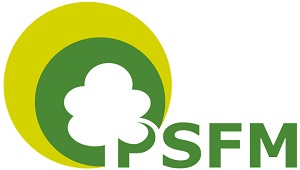TĂNG TRƯỞNG ĐƯỜNG KÍNH VÀ TỶ LỆ CHẾT CỦA CÂY CÁ THỂ Ở RỪNG TỰ NHIÊN TRUNG BÌNH VÀ GIÀU TẠI KHU BẢO TỒN THIÊN NHIÊN VĂN HÓA ĐỒNG NAI
Từ khóa:
Mô hình sinh trưởng cây cá thể,, mô hình Logistic, rừng nhiệt đới,, tỷ lệ sốngTóm tắt
Mô hình tăng trưởng đường kính và tỷ lệ cây chết tự nhiên thường được sử
dụng để dự đoán sản lượng và động thái của lâm phần, nó có ý nghĩa quan
trọng trong quản lý rừng. Bài báo sử dụng dữ liệu được thu thập từ các ô
định vị để xây dựng mô hình tăng trưởng đường kính và tỷ lệ cây chết cho
trạng thái rừng trung bình và giàu tại Khu bảo tồn thiên nhiên Văn hóa
Đồng Nai. Dạng hàm phi tuyến và Logistic đã được lựa chọn để mô phỏng
tăng trưởng đường kính (ZD) và ước lượng xác suất cây bị chết, với các
biến dự báo là kích thước thân cây (đường kính: DBH), phẩm chất và mối
quan hệ vị trí giữa các cây. Kết quả nghiên cứu cho thấy DBH và phẩm
chất cây rừng là các biến có ý nghĩa quan trọng dự đoán ZD. Cụ thể, ZD
tăng theo DBH, sau khi đạt giá trị lớn nhất ZD có xu hướng giảm và tiệm
cận 0 khi DBH tiệm cận tối đa. Tỷ lệ cây bị chết trong chu kỳ điều tra ở
rừng giàu và trung bình lần lượt là 10,94% và 15,67%. Ngoài ra, các nhân
tố có mối tương quan chặt với xác suất cây chết bao gồm: DBH, chỉ số
cạnh tranh tán và phẩm chất cây. Cụ thể, giai đoạn cây non xác suất chết tự
nhiên thường cao, bước vào giai đoạn lâm phần ổn định xác suất cây chết
giảm, nhưng khi cây già cỗi có xu hướng tăng trở lại. Phẩm chất là biến
quan trọng ở các mô hình dự báo sinh trưởng cây cá thể, so với cây có
phẩm chất tốt, ZD và tỷ lệ sống của những cây có phẩm chất trung bình và
xấu giảm rõ rệt. Kết quả của nghiên cứu khẳng định các nhân tố điều tra
như DBH, phẩm chất và chỉ số Hegyi có thể được sử dụng để dự đoán sinh
trưởng cây cá thể ở rừng mưa nhiệt đới có cấu trúc phức
Tài liệu tham khảo
1. Adame, P., Uriarte, M., & Brandeis, T., 2014. Diameter growth performance of tree functional groups in Puerto Rican secondary tropical forests. Forest Systems journal, 23(1): 52-63.
2. Baker, T. R., Swaine, M. D., & Burslem, D. F., 2003. Variation in tropical forest growth rates: combined effects of functional group composition and resource availability. Perspectives in plant ecology, evolution and systematics, 6(1-2), 21-36.
3. Bayat, M., Ghorbanpour, M., Zare, R., Jaafari, A., & Pham, B. T., 2019. Application of artificial neural networks for predicting tree survival and mortality in the Hyrcanian forest of Iran. Computers and Electronics in Agriculture, 164: 1-7
4. Bertini, G., Ferretti, F., Fabbio, G., Raddi, S., Magnani, F., 2019. Quantifying tree and volume mortality in Italian forests. For. Ecol. Manage. 444: 42-49.
5. Biging, G. S., & Dobbertin, M., 1995. Evaluation of competition indices in individual tree growth models. Forest science, 41(2): 360-377.
6. Buford, M. A., & Hafley, W. L., 1985. Probability distributions as models for mortality. Forest science, 31(2): 331-341.
7. Clutter, J. L., Fortson, J. C., Pienaar, L. V., Brister, G. H., & Bailey, R. L., 1983. Timber management: A quantitative approach. John Wiley & Sons, Inc, 333p.
8. Dobbertin, M., & Biging, G. S., 1998. Using the non-parametric classifier CART to model forest tree mortality. Forest Science, 44(4): 507-516.
9. Gourlet-Fleury, S., & Houllier, F., 2000. Modelling diameter increment in a lowland evergreen rain forest in French Guiana. Forest Ecology and Management, 131(1-3): 269-289.
10. Hegyi, F., 1974. A simulation model for managing jack-pine standssimulation. RoyalColl. For, Res. Notes, 30: 74-90.
11. Jones, D. A., Harrington, C. A., & Marshall, D., 2019. Survival, and Growth Response of Douglas-Fir Trees to Increasing Levels of Bole, Root, and Crown Damage. Forest Science, 65(2): 143-155.
12. Kuehne, C., Weiskittel, A. R., & Waskiewicz, J., 2019. Comparing performance of contrasting distanceindependent and distance-dependent competition metrics in predicting individual tree diameter increment and survival within structurally-heterogeneous, mixed-species forests of Northeastern United States. Forest ecology
and management, 433: 205-216.
13. Manion, P. D., 1981. Tree disease concepts. Prentice-Hall, Inc., 416p.
14. Mitsuda, Y., Ito, S., & Takata, K., 2002. Effects of competitive and cooperative interaction among neighboring trees on tree growth in a naturally regenerated even-aged Larix sibirica stand in considering height stratification. Journal of Forest Research, 7(4): 185-191.
15. Nguyễn Thanh Tuấn, Bùi Thị Thu Trang, 2017. Phân tích sự cạnh tranh giữa Chò chai (Hopea recopei) với những loài cây gỗ khác trong rừng kín thường xanh nhiệt đới Khu bảo tồn thiên nhiên Văn hóa Đồng Nai. Tạp chí Khoa học và Công nghệ Lâm nghiệp, (06): 58-66
16. Nguyễn Thị Thu Hiền, 2015. Nghiên cứu cấu trúc và xây dựng mô hình tăng trưởng đường kính rừng tự nhiên lá rộng thường xanh một số khu rừng đặc dụng miền Bắc Việt Nam. Luận án Tiến sỹ Đại học Nông Lâm Thái nguyên, 191 trang.
17. Ohno, Y., Umeki, K., Watanabe, I., Takiya, M., Terazawa, K., Yasaka, M., & Matsuki, S., 2009. Basal area growth and mortality of Betula maximowicziana affected by crown dieback in a secondary forest in Hokkaido, northern Japan. Journal of forest research, 14(1): 37-43.
18. Phân viện Điều tra Quy hoạch rừng Nam Bộ, 2009. Kết quả điều tra xây dựng danh lục thực vật rừng - Danh lục thực vật rừng Khu BTTN&DT Vĩnh Cửu. Tài liệu lưu hành nội bộ.
19. Quinonez-Barraza, G., Zhao, D., Héctor, M., & Corral-Rivas, J. J., 2018. Considering neighborhood effects improves individual dbh growth models for natural mixed-species forests in Mexico. Annals of forest science, 75(3): 78-90
20. R Core Team, 2019. R: A language and environment for statistical computing. R Foundation for Statistical Computing, Vienna (Austria).
21. Renaud, J. P., & Mauffette, Y., 1991. The relationships of crown dieback with carbohydrate content and growth of sugar maple (Acer saccharum). Canadian Journal of Forest Research, 21(7): 1111-1118.
22. Strimbu, V. C., Bokalo, M., & Comeau, P. G., 2017. Deterministic models of growth and mortality for jack pine in boreal forests of western Canada. Forests, 8(11): 410-48
23. Tan, T. (2010. Modelling growth and yield of Dipterocarp forests in Central Highlands of Vietnam. Doctoral dissertation, Technische Universität München, 182p.
24. Temesgen, H., & Mitchell, S. J., 2005. An individual-tree mortality model for complex stands of southeastern British Columbia. Western Journal of Applied Forestry, 20(2): 101-109.
25. Tenzin, J., Tenzin, K., & Hasenauer, H., 2017. Individual tree basal area increment models for broadleaved forests in Bhutan. Forestry: An International Journal of Forest Research, 90(3): 367-380.
26. Tominaga, K., Watmough, S. A., & Aherne, J., 2008. Predicting tree survival in Ontario sugar maple (Acer saccharum) forests based on crown condition. Canadian journal of forest research, 38(7): 1730-174
27. Yahya, Y., Ismail, R., Vanna, S., & Saret, K., 2014. Using data mining techniques for predicting individual tree mortality in tropical rain forest: logistic regression and decision trees approach. In Proceedings of the 8th International Conference on Ubiquitous Information Management and Communication, 5p.
28. Yilmaz, I., 2009. Landslide susceptibility mapping using frequency ratio, logistic regression, artificial neural networks and their comparison: a case study from Kat landslides (Tokat—Turkey). Computers & Geosciences, 35(6), 1125-1138
29. Zhang, S., Amateis, R. L., & Burkhart, H. E., 1997. Constraining individual tree diameter increment and survival models for loblolly pine plantations. Forest Science, 43(3): 414-423.
30. Zhang Z, Papaik MJ, Wang X, Hao Z, Ye J, Lin F., 2017. The effect of tree size, neighborhood competition and environment on tree growth in an old-growth temperate forest. J Plant Ecol 10:970-980












